Ehon Hyaku Monogatari
The Ehon Hyaku Monogatari (絵本百物語, "Picture Book of a Hundred Stories"), also called the Tōsanjin Yawa (桃山人夜話, "Night Stories of Tōsanjin") is a book of yōkai illustrated by Japanese artist Takehara Shunsensai, published about 1841. The book was intended as a followup to Toriyama Sekien's Gazu Hyakki Yagyō series. Like those books, it is a supernatural bestiary of ghosts, monsters, and spirits which has had a profound influence on subsequent yōkai imagery in Japan.
The author's pen name is Tōsanjin (桃山人); however, in the preface it is written as Tōka Sanjin (桃花山人). According to the Kokusho Sōmokuroku (Iwanami Shoten) this is considered to be a gesaku author from the latter half of the Edo period, Tōkaen Michimaro (桃花園三千麿).
It can be said that this is a kind of hundred-tale kaidan (ghost story) book popular in the Edo period, as "100 Tales" is part of the title, but rather than being tales with story titles, yōkai names are printed with illustrations of yōkai, so it could be said that this work is a fusion of kaidan book and picture book.
This book is also known by the title Tōsanjin Yawa because the title on the first page of each volume is "Tōsanjin Yawa, Volume [#]." Scholar of Japanese manners and customs Ema Tsutomu (Nihon Yōkai Henka-shi, 1923) and folklorist Fujisawa Morihiko (Hentai Densetsu-shi, 1926), as well as magazines at that time, introduced this book by the name Tōsanjin Yawa, and so this title became famous. On the other hand, Mizuki Shigeru, in his 1979 Yōkai 100 Monogatari describes it in his references as "Ehon Hyaku Monogatari (Author: Tōsanjin, Year of publication: Unknown)."
It has also been recognized that a book with completely the same contents, titled Ehon Kaidan Zoroe, was published in 2005 by Yumoto Kōichi. The preface's title is changed, and the title of each volume is Ehon Kaidan Zoroe Volume [#] rather than Tōsanjin Yawa Volume [#]. Upon examination, it appears to be an earlier publication than Ehon Hyaku Monogatari, with the relationship that the inscriptions of "Tōsanjin" and "Tōka Sanjin" are mixed, and it also is generally suggested that the first edition of Ehon Hyaku Monogatari may have been published before 1841.
List of creatures
The illustrations below are numbered by volume and appearance order. For example, the third illustration in the first volume is 1–3, and so on.
First Volume
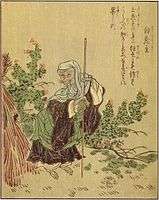
1-1 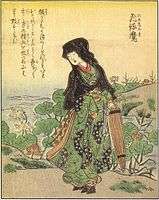
1-2 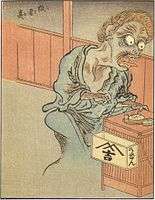
1-3 
1-4 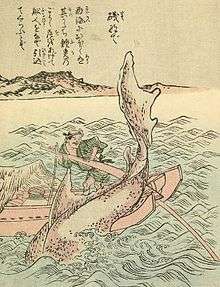
1-5
- 1-1 Hakuzōsu (白蔵主)
- 1-2 Hienma (飛縁魔)
- 1-3 Kowai (狐者異)
- 1-4 Shio-no-Chōji (塩の長司)
- 1-5 Isonade (磯撫)

1-6 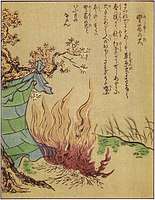
1-7 
1-8 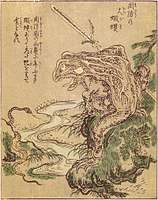
1-9
- 1-6 Shinigami (死神)
- 1-7 Nojukubi (野宿火)
- 1-8 Nebutori (寝肥)
- 1-9 Ōgama (大蝦蟇)
Second Volume
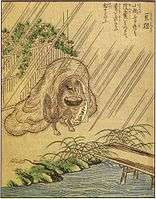
2-1 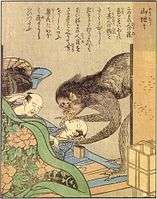
2-2 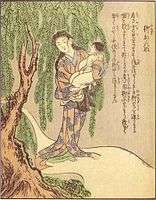
2-3 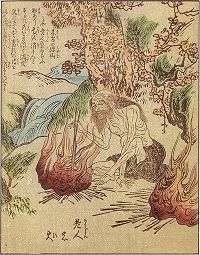
2-4 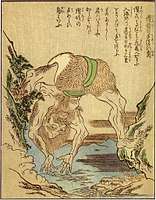
2-5
- 2-1 Mamedanuki (豆狸)
- 2-2 Yamachichi (山地乳)
- 2-3 Yanagi-onna (柳女)
- 2-4 Rōjin-no-hi (老人火)
- 2-5 Tearai-oni (手洗鬼)

2-6 
2-7 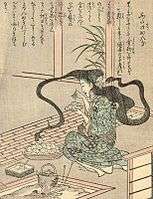
2-8 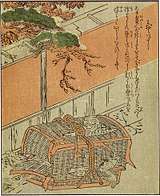
2-9
- 2-6 Shussebora (出世螺)
- 2-7 Kyūso (旧鼠)
- 2-8 Futakuchi-onna (二口女)
- 2-9 Mizoidashi (溝出)
Third Volume
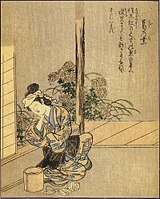
3-1 
3-2 
3-3 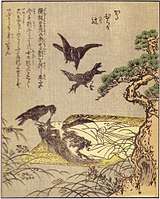
3-4
- 3-1 Kuzunoha (葛の葉)
- 3-2 Shibaemon-tanuki (芝右衛門狸)
- 3-3 Basan (波山)
- 3-4 Katabiragatsuji (帷子辻)

3-5 
3-6 
3-7 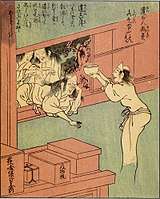
3-8
- 3-5 Haguro-bettari (歯黒べったり)
- 3-6 Akaei-no-uo (赤ゑいの魚)
- 3-7 Funayūrei (船幽霊)
- 3-8 Yuigon-yūrei, Mizukoi-yūrei (遺言幽霊, 水乞幽霊)
Fourth Volume
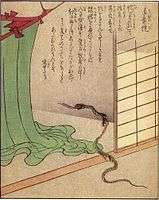
4-1 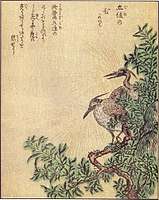
4-2 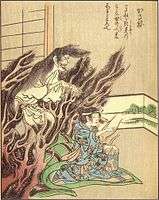
4-3 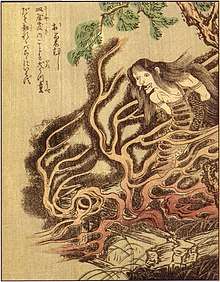
4-4 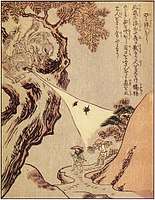
4-5
- 4-1 Teoi-hebi (手負蛇)
- 4-2 Goi-no-hikari (五位の光)
- 4-3 Kasane (累)
- 4-4 Okiku-mushi (於菊虫)
- 4-5 Noteppō (野鉄砲)

4-6 
4-7 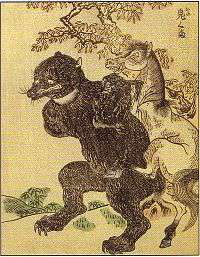
4-8 
4-9
- 4-6 Tenka (天火)
- 4-7 Nogitsune (野狐)
- 4-8 Onikuma (鬼熊)
- 4-9 Kaminari (雷電)
Fifth Volume
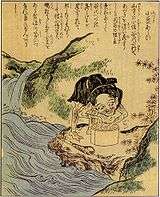
5-1 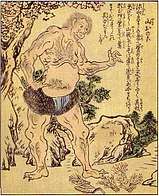
5-2 
5-3 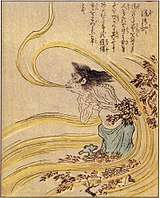
5-4 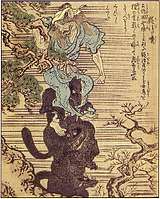
5-5
- 5-1 Azukiarai (小豆洗)
- 5-2 Yama-otoko (山男)
- 5-3 Tsutsugamushi (恙虫)
- 5-4 Kaze-no-kami (風の神)
- 5-5 Kajiga-baba (鍛冶が嬶)
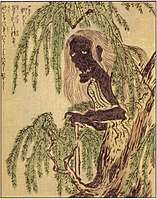
5-6 
5-7 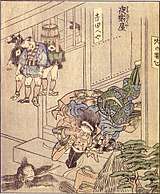
5-8 
5-9
- 5-6 Yanagi-baba (柳婆)
- 5-7 Katsura-otoko (桂男)
- 5-8 Yoru-no-gakuya (夜楽屋)
- 5-9 Maikubi (舞首)